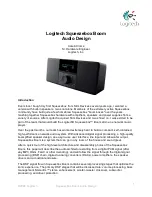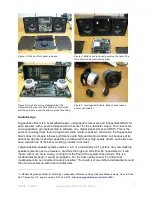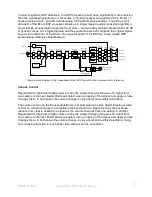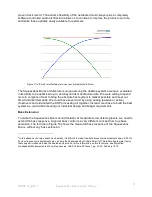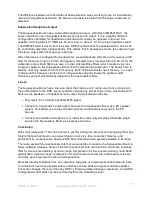
©2008 Logitech
Squeezebox Boom Audio Design
11
The difference between with and without bass-extension was surprising to me. At low listening
levels, with significant extension, the listener can easily be fooled into thinking a subwoofer is
attached.
Subwoofer/Headphone Output
The Squeezebox Boom has a subwoofer/headphone output. A Wolfson WM8501 DAC, the
same chip that is use in Squeezebox Receiver, drives this output. It is in a slightly different
configuration optimized for headphone and subwoofer output, as opposed to line out. It is
capable of driving about 1V RMS into 16-ohm load, or about 1.7V into a high impedance load.
The WM8501 DAC is driven from the same DSP chip that drives the speaker DACs, and it can
be controlled completely independently. This means that in headphone mode, the output will get
full stereo output with full frequency response.
When the device is configured for a subwoofer, we automatically slide the low frequency cutoff
filter for the woofers up to 100 Hz, and create a complementary low pass filter at 100 Hz for the
subwoofer output. Both filters are also 4
th
-order Linkwitz-Riley filters, which create a very nice
crossover between the Squeezebox Boom and the stand-alone subwoofer. The beauty here is
that the user only needs to turn the ‘frequency’ knob of the subwoofer up all the way – no need
to fine-tune the frequency knob since the Squeezebox already knows the optimal cutoff
frequency and will automatically implement the best possible filter.
Line-In
The Squeezebox Boom has a line-level input that can be put to many uses. Since it goes into
the built-in ADCs in the DSP, we can perform virtually any processing on it we want and sent it
back out the speakers, or headphone/sub-output. Some potential uses are:
•
Play music from a friend’s portable MP3 player.
•
Connect to a computer’s audio output and use the Squeezebox Boom as a PC speaker
system. This allows you to play streaming music and simultaneously mix in the PC
sounds.
•
Connect an amplified microphone to it, install the community-developed Karaoke plugin
and use the Squeezebox Boom as a karaoke machine.
Conclusion
Does it all really work? The short answer is yes! By taking into account and managing the many
factors that push and pull on a product design (cost, size, time-to-market, features, and
performance), we believe we have built the best streaming audio system available in its class.
There are several future enhancements that we would like to make to the Squeezebox Boom in
future software releases. Some of the future enhancements could include: automatic loudness
filter for low-volume listening; dynamic range compression for low-volume listening; multi-band
equalization; dynamic range compression for high-noise environments; and whatever else we
can think up to help improve the overall experience.
Most importantly, feedback from our customers will guide us toward what enhancements, fixes,
or corrections need to be implemented, and these can be added in regular software updates.
For some changes, there won’t be any DSP or firmware related changes necessary, since DSP
configuration commands can be sent directly from the streaming server.

